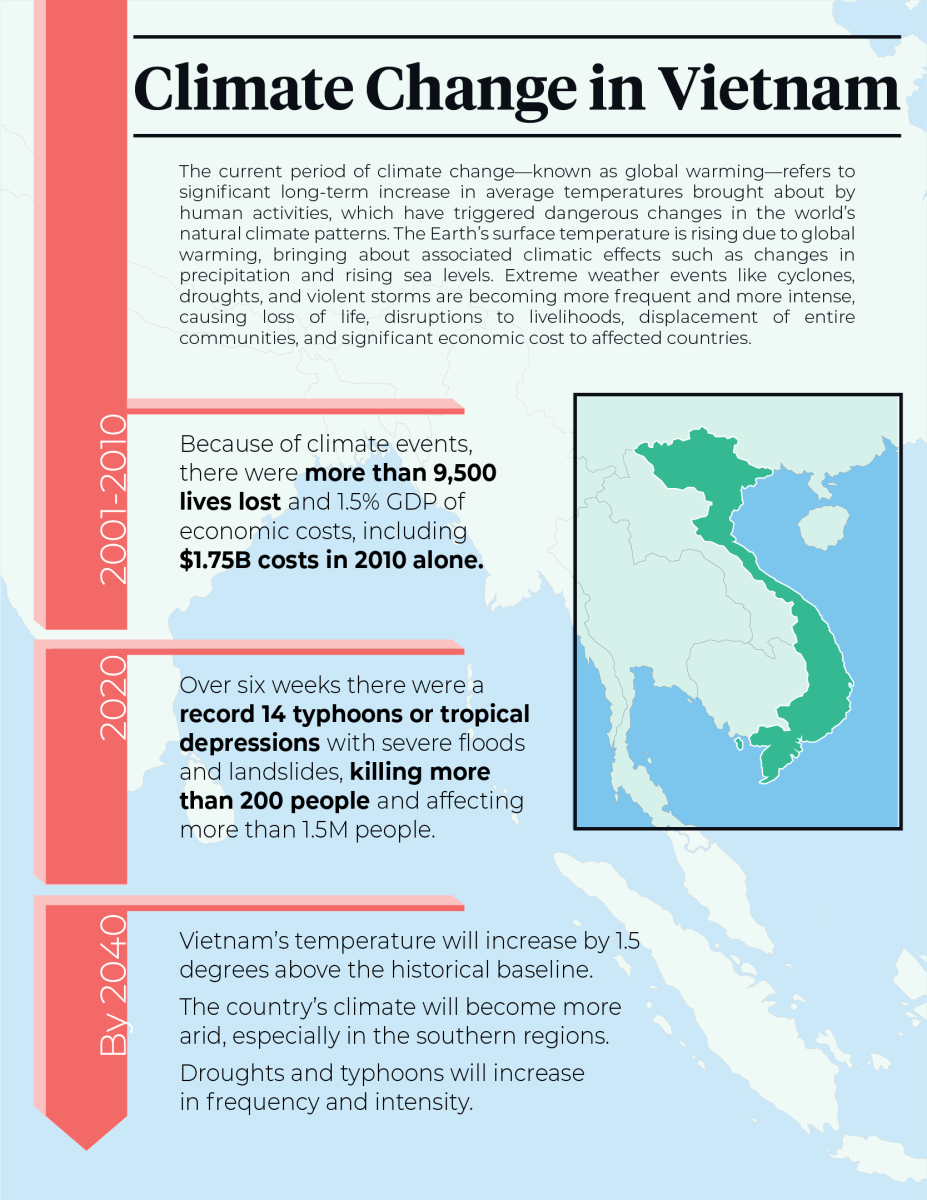
Climate change is one of the biggest challenges of our time. While the exact impacts of climate change are nearly impossible to predict, experts agree that if current trends continue, the effects will be devastating. The fact is that global average temperatures continue rising and are already showing serious, damaging, and disruptive climate-related events. Melting ice is contributing to the rise of sea-levels, directly affecting communities in low lying areas, such as river deltas and tropical islands. Warmer temperatures are causing more intense droughts that threaten crops and wildlife. Fresh water supply is progressively diminishing due to drought and salination associated with sea level rise. Overall, extreme weather events are becoming more frequent. Scientists in the international community have already documented these negative effects and expect many more to come in the near future should temperatures continue climbing.
When it comes to climate change, Vietnam and its people are especially susceptible, as it is considered one of the most hazard-prone countries in the world. Its long coastline facing the East Sea, mountainous north, and the Mekong River delta in the south make Vietnam particularly vulnerable. Typhoons, floods, droughts, and landslides are frequent, causing losses equivalent to 1.5 percent of Vietnam’s annual GDP, affecting ecosystems and livelihoods all around the country. Water, agriculture, energy, transportation, infrastructure, wildlife, and human health are all being impacted. So, what we can do to slow down, and even prevent, some of these effects from happening?

Transport infrastructure is directly connected to climate change in two ways. First, transport infrastructure is seriously affected by these severe climatic events, both in the short- and long-term. Short-term impacts include loss of life, road closures, and loss of connectivity associated with landslides and floods. Longer-term impacts, such as increased maintenance costs and shorter lifespans for roads, bridges, and other transport infrastructure, are less apparent but also detrimental, particularly in countries with limited budgets for this type of maintenance.
Second, when properly planned, designed, and implemented, transport infrastructure can significantly contribute to mitigating the effects of climate change and ensuring communities and countries are more resilient and better prepared to face its negative consequences. Aus4Transport, DT Global’s transport infrastructure project in Vietnam, is playing a crucial part in supporting the Government of Vietnam to develop the “right infrastructure”—infrastructure that is carefully designed to be respectful of the environment and resilient to the recurrent difficult weather conditions that the country is experiencing.
Aus4Transport, an AUD$30 million grant facility partnership between the Government of Australia, through the Department of Foreign Affairs and Trade (DFAT), and the Government of Vietnam’s Ministry of Transport (MOT), is supporting a range of initiatives that will both directly and indirectly assist Vietnam in addressing climate risks and developing a more resilient transport infrastructure.
Through part of the project that supports Facilitating National Transport Projects, DFAT is assisting MOT to better prepare projects by funding the preparatory and design phase, supporting the detailed design and documentation of two large projects—the Central Highlands Connectivity Improvement Project (CHCIP) and the Northern Mountains Provinces Transport Connectivity Project (NMPTCP). Both CHCIP and NMPTCP focus on ensuring road upgrades are designed to be climate resilient, decreasing the risk of damaging landslides whilst simultaneously reducing the environmental impacts, such as emissions and waste, of these implementation techniques. When designing the roads and bridges, Aus4Transport is also applying climate modelling, which uses scientific research to understand how temperatures and rainfall patterns will evolve in the long-term. Understanding the potential climate scenarios to which the area will be exposed allows us to design roads that are more resilient to weather hazards, making them safer, reducing long-term maintenance and repair costs, and extending their lifespan.
Through a part of the project supporting Unlocking opportunities through innovation, DFAT is also assisting MOT to strengthen the response to the specific needs of various transport users (including women, people with disabilities, and ethnic minorities), as well as prioritising important issues related to the development of the transport sector, such as road safety and climate change.
Aus4Transport is doing this through research, innovation, proposed policy reform, and training. For example, the Environmental and Social Benefits and Costs of Transport Infrastructure Projects (ESIA) Activity focuses on capacity building to improve the assessment and management of potential environmental and social impacts associated with MOT infrastructure investment projects. The objective of the activity is to develop three transport sector standards also known as Tiêu chuẩn cơ sở (TCCS), one each for the road, railway, and inland waterways sector.
The TCCS will clearly and comprehensively describe standards, processes, and procedures for identifying and assessing impacts, as well as developing mitigation measures caused by roads, railways, and inland waterways infrastructure projects. The Activity will also develop a training plan and conduct a series of facilitated learning, mentoring and coaching, and application of learning activities for MOT staff on best practices for the sector. The final output will involve assisting MOT’s Department of Environment to establish a help desk and support all those who have doubts when applying the guidelines to transport infrastructure projects.
Through effective planning coupled with the right public policy environment, it is possible to build ‘right infrastructure’—ensuring that we are supporting infrastructure that is designed and operated in a way that anticipates, prepares for, and adapts to changing climate conditions. Right infrastructure can better withstand, respond to, and rapidly recover from the disruptions and damage caused by extreme weather events. These efforts will save lives and contribute to social and economic development for both the communities directly affected and the country as a whole.